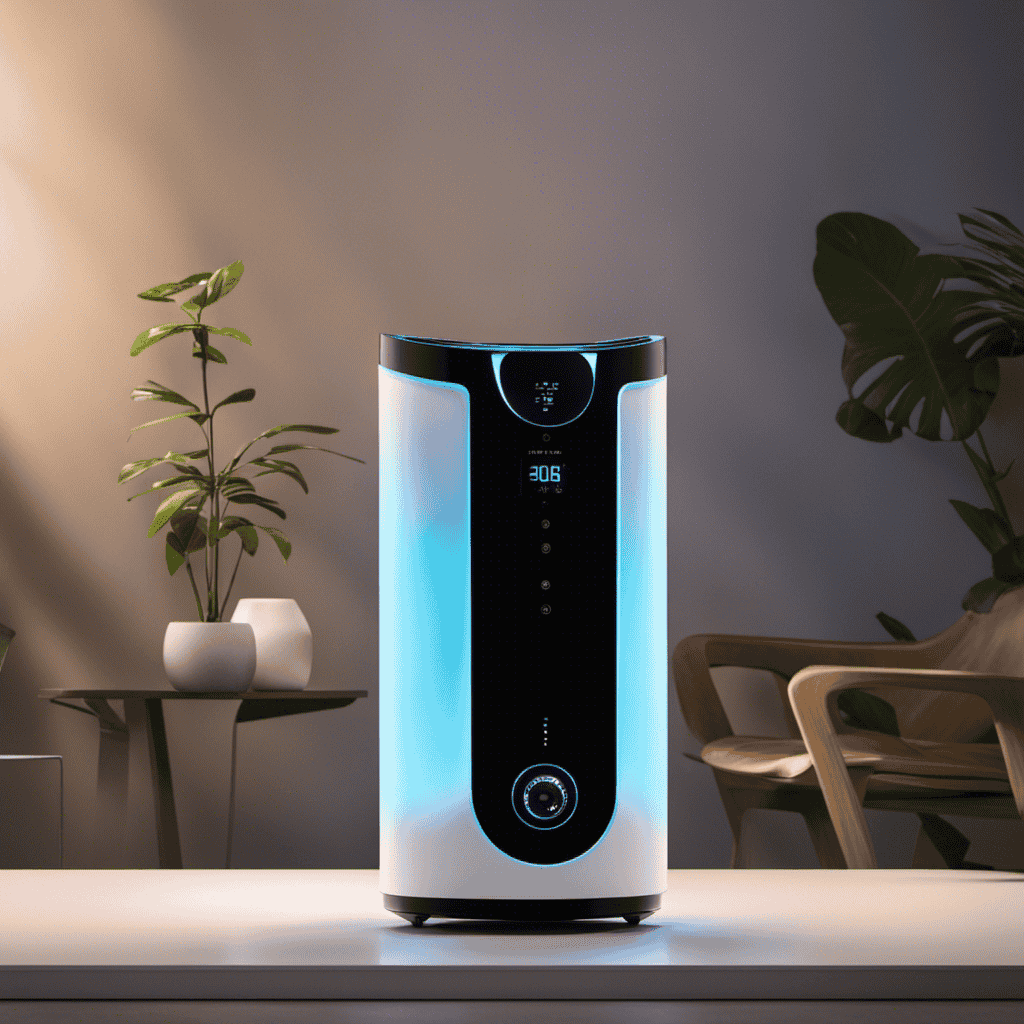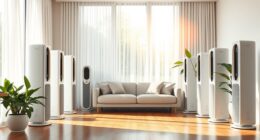I’ll be completely honest with you – indoor air quality has always been a worry for me. This is why I decided to invest in a UV bulb air purifier.
These amazing devices use ultraviolet light to zap away harmful bacteria, viruses, and allergens floating in the air.
In this article, I’ll delve into how UV bulb air purifiers work, the benefits they offer, and important factors to consider before making a purchase.
Let’s shed some light on this powerful air purification technology.
Key Takeaways
- UV bulb air purifiers use ultraviolet light to kill bacteria and viruses in the air
- UV bulb purifiers do not require regular filter replacements or cleaning
- UV bulb air purifiers help eliminate harmful bacteria and viruses
- UV bulb air purifiers require bulb replacement instead of filter replacement
How Does a UV Bulb Air Purifier Work
A UV bulb air purifier uses ultraviolet light to kill bacteria and viruses in the air. This technology offers several advantages over other types of air purifiers.
One major advantage is its ability to effectively eliminate harmful microorganisms from the air. Ultraviolet light has been proven to be highly effective in destroying bacteria and viruses, making it an ideal choice for those concerned about airborne pathogens.
Another advantage of UV bulb air purifiers is their low maintenance requirements. Unlike some other types of air purifiers, UV bulb purifiers do not require regular filter replacements or cleaning. This can save both time and money in the long run.
When compared to other types of air purifiers, UV bulb purifiers offer a reliable and efficient solution for improving indoor air quality.
Benefits of Using a UV Bulb Air Purifier
One of the benefits of using a UV bulb air purifier is that it can help eliminate harmful bacteria and viruses in the surrounding area. Unlike traditional air purifiers that rely on filters to trap particles, UV bulb air purifiers use ultraviolet light to kill microorganisms. The effectiveness of UV bulb air purifiers in removing viruses and bacteria has been studied extensively. Research has shown that UV-C light, which is emitted by these purifiers, can effectively destroy the DNA and RNA of microorganisms, rendering them inactive and unable to reproduce. To give you a better understanding of the effectiveness of UV bulb air purifiers, here is a comparison table:
| UV Bulb Air Purifier | Traditional Air Purifier |
|---|---|
| Eliminates viruses | Filters out particles |
| Kills bacteria | Traps dust and allergens |
| Inactivates mold spores | Removes pet dander |
| Requires bulb replacement | Requires filter replacement |
Factors to Consider When Choosing a UV Bulb Air Purifier
When choosing a UV bulb air purifier, it’s important to consider factors such as price, size, and maintenance requirements. These three factors play a crucial role in determining the effectiveness and convenience of the device.
Air purifier features vary across different models, so it’s essential to choose one that suits your specific needs. Look for features such as multiple fan speeds, filter replacement indicators, and programmable timers.
Additionally, UV C technology is an important aspect to consider. It utilizes ultraviolet light to kill bacteria, viruses, and other harmful microorganisms present in the air. This technology helps to improve the overall air quality and eliminate allergens.
Taking these factors into account will ensure that you choose the right UV bulb air purifier for your home or office.
Now, let’s explore some common misconceptions about UV bulb air purifiers.
Common Misconceptions About UV Bulb Air Purifiers
Contrary to popular belief, misconceptions about UV bulb air purifiers can lead to misunderstandings about their effectiveness. Let’s address some of the common misconceptions surrounding UV bulb air purifiers and shed light on the truth.
-
UV bulb air purifiers and allergies: One common misconception is that UV bulb air purifiers can effectively eliminate allergens such as pollen and pet dander. While UV bulbs can help kill certain microorganisms, they are not designed to remove larger particles like allergens from the air.
-
UV bulb air purifiers and mold prevention: Another misconception is that UV bulb air purifiers can completely prevent mold growth. While UV light can inhibit the growth of mold in certain conditions, it is not a foolproof method for mold prevention. Proper moisture control and ventilation are still essential in preventing mold growth.
It is important to understand the limitations of UV bulb air purifiers and not solely rely on them for allergy relief or mold prevention. To maximize their effectiveness, regular maintenance and care are crucial. Now, let’s explore some maintenance and care tips for UV bulb air purifiers.
Maintenance and Care Tips for UV Bulb Air Purifiers
To keep your UV bulb air purifier running efficiently, make sure to regularly clean or replace the filter. Cleaning techniques for UV bulb air purifiers vary depending on the model and manufacturer. Some filters can be washed with water and mild soap, while others may require replacement. It is important to consult the user manual or manufacturer’s instructions for specific cleaning instructions. Additionally, troubleshooting common issues with UV bulb air purifiers is essential for proper maintenance. Issues such as a burnt-out bulb, malfunctioning fan, or a clogged filter can affect the effectiveness of the purifier. If you encounter any problems, refer to the troubleshooting section of the user manual or contact customer support for assistance.
| Cleaning Techniques | Troubleshooting Issues | Maintenance Tips |
|---|---|---|
| Wash with mild soap | Burnt-out bulb | Regularly clean |
| Replace filter | Malfunctioning fan | Replace as needed |
| Consult manual | Clogged filter | Follow instructions |
Frequently Asked Questions
Are UV Bulb Air Purifiers Safe for Use Around Children and Pets?
UV bulb air purifiers are safe for use around children and pets. They offer several benefits over traditional air purifiers, such as effectively eliminating airborne pathogens and reducing the spread of germs.
Can a UV Bulb Air Purifier Remove All Types of Airborne Pollutants?
A UV bulb air purifier is effective in removing various types of airborne pollutants. Its ultraviolet light destroys microorganisms, such as bacteria and viruses, providing a clean and healthy indoor environment. The benefits of UV bulb air purifiers include improved air quality and reduced respiratory issues.
Can a UV Bulb Air Purifier Eliminate Odors From the Air?
Eliminating odors is one of the many benefits of a UV bulb air purifier. By using ultraviolet light, it neutralizes and destroys odor-causing molecules in the air, leaving your space fresh and clean.
Do UV Bulb Air Purifiers Require Any Special Installation or Setup?
UV bulb air purifiers do not require any special installation or setup. They can be easily integrated into existing HVAC systems or used as standalone units. Simply plug them in, replace the bulbs periodically, and enjoy cleaner air.
How Long Does a UV Bulb in an Air Purifier Typically Last Before It Needs to Be Replaced?
UV bulb air purifiers typically last for about 9-12 months before needing replacement. However, cost-effective alternatives like LED UV-C technology offer longer lifespan and similar benefits.
Conclusion
In conclusion, after thorough research and investigation, it’s clear that UV bulb air purifiers are an effective and efficient way to improve indoor air quality.
Contrary to some misconceptions, these purifiers use ultraviolet light to kill bacteria, viruses, and other harmful microorganisms, providing a healthier living environment.
The benefits of using a UV bulb air purifier are numerous, including reducing allergies, eliminating odors, and preventing the spread of airborne diseases.
With proper maintenance and care, these purifiers can be a valuable addition to any home or office.










